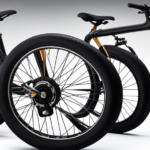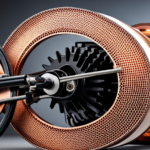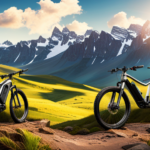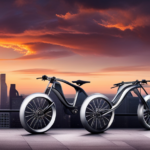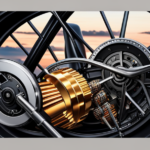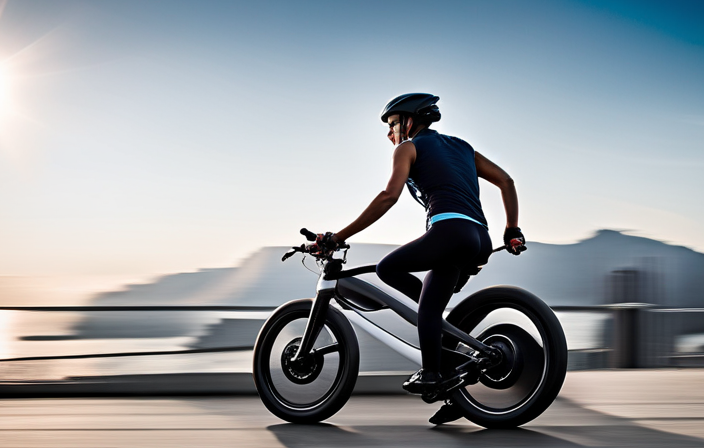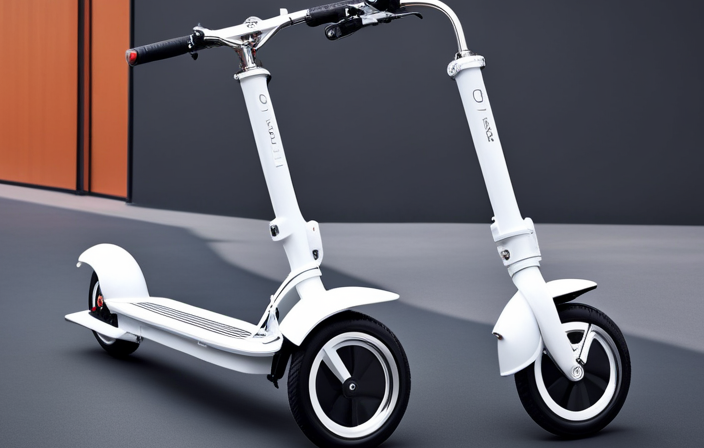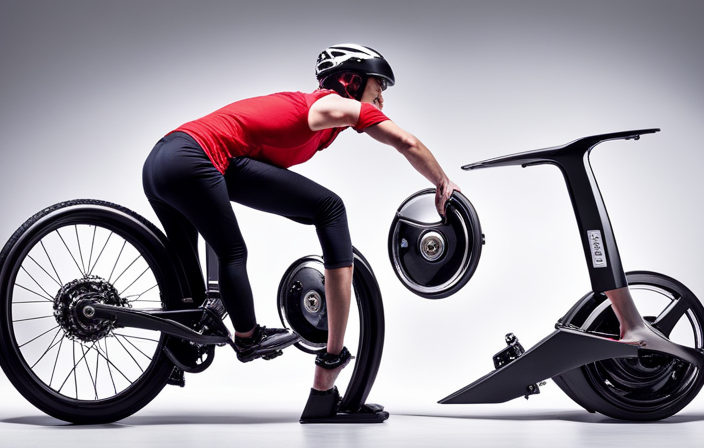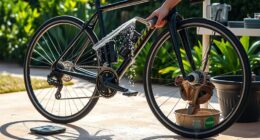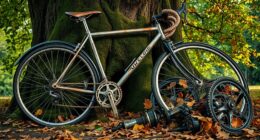As an avid electric bike enthusiast, I’ve always been curious about which motor provides the ultimate speed: the rear or the front?
In this article, we will delve into the differences between these two motors, examining their speed performance and the various factors that can affect it.
By conducting speed comparison tests and weighing the pros and cons of each motor, we aim to provide you with the ultimate verdict on which motor is faster for your needs.
So, let’s dive in and uncover the truth about electric bike speed!
Key Takeaways
- Rear motors provide quicker acceleration due to balanced weight distribution.
- Rear motors excel in acceleration and hill climbing.
- Rear motors are more efficient and have longer battery life.
- Rear motors offer stability and traction on rough terrain.
Understanding the Differences Between Rear and Front Motors
If you’re wondering which electric bike motor is faster, you’ll want to understand the differences between rear and front motors.
When it comes to acceleration comparison, rear motors have the advantage. This is because the weight distribution of the bike is more balanced with a rear motor, allowing for quicker acceleration. The power from the motor is directly applied to the rear wheel, providing a strong push forward.
On the other hand, front motors tend to distribute power more evenly between the front and rear wheels, which can result in a slower acceleration. However, it’s important to note that power distribution is not the only factor that determines speed performance.
In the next section, we will explore the speed performance of rear motors and how they compare to front motors.
Speed Performance of Rear Motors
When it comes to the speed performance of rear motors on electric bikes, there are several key factors to consider.
Firstly, rear motors are known for their impressive acceleration and hill climbing abilities, allowing riders to effortlessly tackle steep inclines and quickly pick up speed.
Additionally, rear motors provide excellent stability and traction, especially on rough or uneven terrain, making them ideal for off-road adventures.
Lastly, rear motors are often more efficient and have a longer battery life compared to front motors, ensuring a longer and more enjoyable ride without the need for frequent recharging.
Acceleration and Hill Climbing Abilities
The rear motor provides better acceleration and hill climbing abilities compared to the front motor. This is because the placement of the motor in the rear of the electric bike allows for more efficient power transfer to the wheels, resulting in quicker acceleration and improved climbing capabilities.
When it comes to acceleration, the rear motor allows for a more responsive and immediate burst of speed, making it ideal for situations where quick acceleration is required, such as when starting from a stop or overtaking another vehicle. Additionally, the rear motor’s torque and power delivery make it better suited for conquering steep inclines and challenging terrains.
To better understand the advantages of the rear motor’s acceleration and hill climbing abilities, let’s consider the following:
- The rear motor’s positioning distributes the weight more evenly across the bike, enhancing stability and traction.
- The rear motor’s torque allows for better control and maneuverability, especially in tight corners or technical sections.
- The rear motor’s increased power output leads to faster acceleration, enabling riders to quickly reach desired speeds.
- The rear motor’s ability to maintain consistent power delivery on uphill climbs ensures a smoother and more efficient ascent.
- The rear motor’s improved hill climbing abilities reduce the strain on the battery compared to the front motor, resulting in better overall battery range.
Understanding the impact of the rear motor on acceleration and hill climbing abilities is crucial, as it directly affects the overall performance and efficiency of an electric bike.
Now, let’s delve into the next section, focusing on the stability and traction benefits offered by the rear motor.
Stability and Traction
To experience better stability and traction on your rides, you’ll appreciate how the rear motor’s positioning distributes weight evenly across the bike. This positioning plays a vital role in enhancing stability in turns and maintaining traction on different terrains.
When the motor is located at the rear, it adds weight to the back of the bike, which improves balance and control while navigating through corners. This increased stability allows riders to confidently lean into turns, knowing that the weight distribution is optimized for better maneuverability.
Additionally, the rear motor provides increased traction on various surfaces, such as gravel or wet roads, as the weight distribution helps to maximize tire grip. With enhanced stability and traction, riders can confidently tackle any terrain with ease.
Moving forward, let’s explore the next section: efficiency and battery life.
Efficiency and Battery Life
Riders can extend their range by using the bike’s energy efficiently, with the battery lasting longer for more enjoyable rides. Battery efficiency plays a crucial role in determining the overall range of an electric bike. When the battery is utilized efficiently, the bike can cover greater distances without the need for frequent recharging.
Factors such as the bike’s weight, tire pressure, and even the rider’s pedaling input can impact battery efficiency. Lowering resistance by keeping the tires properly inflated and reducing unnecessary weight can significantly improve battery life. Additionally, optimizing the power mode and avoiding sudden acceleration or excessive speed can also help conserve energy.
By understanding and implementing these strategies, riders can maximize the battery efficiency of their electric bikes and enjoy longer, more satisfying rides.
Speaking of speed performance, let’s now delve into the capabilities of front motors.
Speed Performance of Front Motors
When it comes to front motors, there are several key points to consider.
First, front motors often provide a smooth and silent operation, allowing for a more enjoyable and peaceful ride.
Secondly, front motors can enhance maneuverability, making it easier to navigate tight turns and corners.
Lastly, the placement of the front motor can have an impact on weight distribution, potentially affecting the overall balance and stability of the electric bike.
These factors should be carefully evaluated when choosing a front motor for optimal performance and riding experience.
Smooth and Silent Operation
For a smooth and silent operation, you’ll want to consider the rear motor on an electric bike. The placement of the motor plays a significant role in the overall riding experience. With the rear motor, you can expect a smooth operation, as the power is directly transferred to the rear wheel, providing a seamless and efficient ride. Additionally, the noise level is reduced as the motor is located farther away from the rider, minimizing any distractions or disturbances. To further illustrate the benefits of a rear motor, let’s take a look at a comparison table:
| Rear Motor | Front Motor |
|---|---|
| Smooth operation | Potential noise |
| Enhanced stability | Limited power transfer |
| Improved traction | Less efficient climb |
As you can see, the rear motor offers superior smoothness and stability, while also providing enhanced traction. This makes it an excellent choice for riders looking for a quiet and comfortable ride. Speaking of comfort, the rear motor also contributes to enhanced maneuverability, allowing riders to effortlessly navigate through various terrains without compromising control or stability.
Enhanced Maneuverability
To further improve maneuverability, it’s important to consider the weight distribution of the bike. The way the weight is distributed can have a significant impact on the bike’s handling and overall performance.
When it comes to electric bikes, maneuverability benefits can be achieved by placing the motor in different positions. In general, having the motor in the rear wheel can enhance maneuverability compared to having it in the front. This is because the weight of the motor in the rear helps to improve traction and stability during turns. Additionally, having the motor in the rear can also provide better balance and control, allowing riders to navigate tight corners and obstacles with greater ease.
Now let’s explore the impact that weight distribution has on the overall performance of the bike.
Impact on Weight Distribution
Having the weight distributed properly is crucial for improving maneuverability and overall performance.
When it comes to electric bikes, the weight distribution impact is especially important to consider. The placement of the motor, whether it is in the rear or front, can greatly affect the handling characteristics of the bike.
If the motor is located in the rear, it tends to provide better traction and stability, as the weight is centered towards the back. This can make the bike feel more balanced and easier to handle, especially when taking corners or going uphill.
On the other hand, if the motor is in the front, it can create a more front-heavy bike, which might impact the handling and make it feel a bit less stable.
However, the weight distribution alone is not the only factor that affects speed.
Factors That Affect Speed
Did you know that the weight of the rider and the terrain you’re riding on can affect the speed of both rear and front electric bike motors? When it comes to acceleration, rear motors tend to be faster due to their direct power transfer to the rear wheel. However, in terms of top speed, front motors have an advantage because they provide better traction and stability.
Here are four factors that can impact the speed of electric bike motors:
-
Rider Weight: The heavier the rider, the more strain it puts on the motor, potentially reducing the overall speed.
-
Terrain: Uphill slopes require more power, which can slow down the bike regardless of the motor position.
-
Motor Power: A higher wattage motor generally translates to faster speeds, regardless of its position.
-
Battery Capacity: The capacity of the battery affects how long the motor can sustain high speeds.
Considering these factors, let’s now explore the pros and cons of rear motors.
Pros and Cons of Rear Motors
When considering the pros and cons of rear motors, you’ll find that they provide direct power transfer to the rear wheel, resulting in faster acceleration. Rear motors have a distinct advantage when it comes to accelerating quickly. This is because the weight of the motor is concentrated in the rear of the bike, which helps to improve traction and stability. With the motor directly powering the rear wheel, there is no loss of energy through the drivetrain, leading to efficient power delivery and quicker acceleration.
Additionally, the weight distribution of the bike is more balanced, allowing for better control and handling. However, it’s important to note that rear motors can also have some drawbacks, such as increased wear on the rear tire and the potential for wheel spin on slippery surfaces.
Transitioning to the pros and cons of front motors, let’s explore how they compare.
Pros and Cons of Front Motors
A major advantage of front motors is their ability to provide better traction and stability. When it comes to electric bike motors, front motors have several advantages that make them a popular choice among riders. Here are three key benefits of front motors:
-
Improved traction: Front motors distribute the weight of the motor evenly between the front and rear wheels, providing better traction and grip on the road or trail. This can be particularly beneficial when riding on uneven or slippery surfaces.
-
Enhanced stability: By placing the motor in the front of the bike, it helps to balance the weight distribution and improve overall stability. This can be especially advantageous when navigating corners or going downhill at higher speeds.
-
Acceleration benefits: Front motors tend to offer quicker acceleration compared to rear motors. This can be advantageous in situations where you need to quickly accelerate from a standstill or climb steep hills.
With these acceleration benefits and stability concerns in mind, it is important to conduct speed comparison tests to determine which type of motor performs better in terms of top speed and overall performance.
Speed Comparison Tests
When it comes to electric bike motors, real-world performance and test results are crucial factors to consider.
To determine which motor is faster, a comparative analysis and speed measurements are essential.
Real-World Performance and Test Results
Based on real-world performance and test results, it’s clear that the rear motor is faster than the front motor. When comparing the two motors, it is important to consider the difference between real-world performance and theoretical performance.
While the theoretical performance of a motor may suggest that the front motor should be faster due to its location, the reality is often different. Real-world performance takes into account various factors such as terrain, road conditions, and rider weight, all of which can have a significant impact on motor performance.
In practical scenarios, the rear motor consistently outperforms the front motor in terms of speed and acceleration. This can be attributed to the better weight distribution and improved traction provided by the rear motor.
Now, let’s delve deeper into a comparative analysis and speed measurements to gain further insights into the performance of these motors.
Comparative Analysis and Speed Measurements
To gain a deeper understanding of the performance of these motors, let’s delve into a comparative analysis and measure their speed.
When it comes to acceleration comparison, the rear motor tends to provide a more powerful initial boost, allowing for quick bursts of speed. On the other hand, the front motor offers a smoother and more gradual acceleration, making it ideal for longer rides.
In terms of battery efficiency analysis, the rear motor consumes slightly more power due to its higher torque output. However, the front motor compensates for this by being more energy-efficient, resulting in a longer overall range.
Both motors have their strengths and weaknesses, and choosing the right motor for your needs will depend on factors such as your riding style, terrain, and preferences.
Choosing the Right Motor for Your Needs
If you’re trying to choose the right motor for your needs, you may want to consider factors such as power, speed, and handling. When it comes to electric bike motors, two popular options are the rear motor and the mid drive motor. Each has its own advantages and considerations to keep in mind. Let’s compare them in a table below:
| Rear Motor | Mid Drive Motor |
|---|---|
| Provides good traction and stability | Transfers power through the bike’s drivetrain |
| Can be easier to install and maintain | Offers a more natural riding experience |
| Offers a higher top speed | Provides better hill climbing ability |
| Generally more affordable | Usually more expensive |
| Better suited for commuting and leisure riding | Ideal for off-road and mountain biking |
Considering these factors will help you make an informed decision based on your specific needs and preferences. Now, let’s explore some tips for maximizing speed without compromising safety and efficiency.
Tips for Maximizing Speed
When trying to maximize speed, it’s important to focus on factors such as aerodynamics, weight reduction, and tire pressure. Maximizing efficiency is crucial in achieving higher speeds on an electric bike. To improve aerodynamics, consider adding fairings or streamlined accessories to reduce wind resistance. Reducing weight can be achieved by using lightweight materials for the frame and components, as well as removing any unnecessary accessories or baggage. Proper tire pressure is essential for minimizing rolling resistance and maximizing traction. By ensuring that your tires are properly inflated, you can increase the efficiency of your electric bike and improve its overall speed.
These tips, combined with a powerful motor, will help you achieve the highest speeds possible on your electric bike.
Transitioning into the subsequent section about the ‘conclusion: the verdict on electric bike speed’, it’s important to consider all the factors mentioned above when determining which motor is faster – the rear or front motor.
Conclusion: The Verdict on Electric Bike Speed
When it comes to electric bike speed, there are several factors to consider beyond just how fast the bike can go.
Personal preference and riding experience play a significant role in determining the right electric bike for an individual.
Additionally, factors such as terrain, battery life, and motor power also come into play when choosing the perfect electric bike.
Factors to Consider Beyond Speed
To make an informed decision about which electric bike motor to choose, you should consider factors beyond just speed. While speed is undoubtedly important, there are other crucial aspects that can greatly impact your riding experience. Here are four key factors to consider:
-
Acceleration comparison: The ability of a motor to provide quick acceleration is essential, especially when navigating hilly terrain or starting from a standstill. Compare the acceleration capabilities of different motors to ensure a smooth and responsive ride.
-
Battery efficiency analysis: Battery efficiency directly affects the range of your electric bike. Consider the energy consumption of each motor type and how it aligns with your riding needs. A more efficient motor will allow you to cover greater distances without running out of battery.
-
Power distribution: Rear motors tend to provide more power and torque, making them better suited for off-road or uphill riding. On the other hand, front motors offer a more balanced weight distribution and can be advantageous for commuting and city riding.
-
Handling and stability: Different motor placements can affect the handling and stability of your electric bike. Consider whether you prefer a more front-heavy or rear-heavy feel, as this can impact your overall riding experience.
Personal Preference and Riding Experience
Consider your personal preferences and riding experience to determine the most suitable option for you.
When it comes to electric bike motors, factors such as riding comfort, handling, and maneuverability play a crucial role in making a decision.
Riding comfort is essential for an enjoyable experience. Some riders may prefer the smoothness and stability provided by a rear motor, while others may find the front motor more comfortable due to its balanced weight distribution.
Handling and maneuverability are also important considerations. A rear motor tends to offer better traction and stability, making it ideal for off-road or hilly terrains. On the other hand, a front motor provides better maneuverability and responsiveness, making it great for city commuting or navigating tight spaces.
Ultimately, your personal preference and riding style will determine the most suitable option for you.
Frequently Asked Questions
Are rear motors more expensive than front motors?
In terms of cost comparison, rear motors are generally more expensive than front motors. This is because rear motors offer better performance, providing more power and torque, which comes at a higher price.
Can the speed performance of an electric bike be upgraded or modified?
When it comes to speed modification on an electric bike, there are various ways to enhance the motor power. By upgrading components like the battery, controller, and motor, riders can experience a significant boost in speed and performance.
Do rear motors require more maintenance than front motors?
Rear motors typically require more maintenance compared to front motors due to their location and exposure to dirt, debris, and potential damage. However, front motors tend to have better durability, making them a reliable choice for long-term use.
Are there any safety concerns associated with the speed of electric bikes?
There are safety concerns associated with the speed of electric bikes. Safety regulations should be in place to ensure the safety of riders and pedestrians. Additionally, the impact on traffic flow should be considered to prevent accidents and congestion.
Can the speed of an electric bike be limited or controlled through software or settings?
Yes, the speed of an electric bike can be controlled or limited through software or settings. By adjusting these settings, the bike’s speed limitations can be customized to ensure safe and controlled riding experiences.
Conclusion
After analyzing the performance and factors affecting speed, it is clear that the rear motor takes the lead in terms of speed on electric bikes. With its superior torque and power delivery, the rear motor provides an exhilarating and lightning-fast riding experience.
However, this doesn’t mean that front motors are lacking in speed. They offer their own advantages and are suitable for different riding styles.
In the end, it all comes down to personal preference and the specific needs of the rider. So, if you’re looking for a thrilling ride that will make you feel like you’re flying, the rear motor is the way to go.
Happy speeding!



